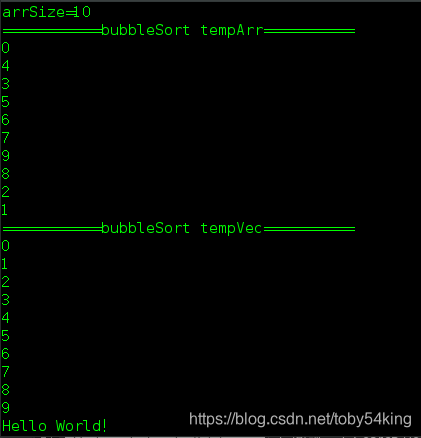版权声明:本文为博主原创文章,转载请注明出处。作者:ISmileLi 博客地址:http://blog.csdn.net/toby54king。 https://blog.csdn.net/toby54king/article/details/83689160
一、说明:冒泡排序的原理在注释中,文中冒泡排序使用了模板来传入数据,详细情况看下面的测试代码。
二、测试代码
#include <iostream>
#include <vector>
using namespace std;
/******************************
冒泡排序:从数组的右到左对数组进行两两比较排序,大的放到最右边。
第一遍比较后最小的元素在最左边的0号位置,第二遍开始将第2小的数
据放到1号位置,一直比较到只剩最后两个元素确认是否交换为止。
优点:1、简单
缺点:1、在各种情况下的比较次数都相等,效率低
算法复杂度:O(n~n^2) 空间复杂度:O(1)
******************************/
// 实现方法一
template<typename T>
void bubbleSort1(T data[], int n)
{
for(int i=0; i<n-1; i++)
{
for(int j=n-1; j>i; j--)
{
if(data[j]<data[j-1])
{
T temp = data[j];
data[j] = data[j-1];
data[j-1] = temp;
}
}
}
}
// 实现方法二冒泡改进版
template<typename T>
void bubbleSort2(T data[], int n)
{
// 设置标志位用来查看是否发生交换,如果没有发生交换说明排序已经完成,不需要再进行排序
// 这种情况发生的概率不多,这种改进需要额外保存一个变量,效果可能还不如第一种效果好
bool flag = true;
for(int i=0; i<n-1 && flag; i++)
{
flag = false;
for(int j=n-1; j>i; j--)
{
if(data[j]<data[j-1])
{
T temp = data[j];
data[j] = data[j-1];
data[j-1] = temp;
flag = true;
}
}
}
}
// 实现方法三
template<typename T>
void bubbleSort3(vector<T> &data)
{
for(int i=0; i<data.size()-1; i++)
{
for(int j=data.size()-1; j>i; j--)
{
if(data[j] < data[j-1])
{
T temp = data[j];
data[j] = data[j-1];
data[j-1] = temp;
}
}
}
}
int main()
{
int tempArr[] = {0,4,3,5,6,7,9,8,2,1};
int arrSize = sizeof(tempArr)/sizeof(tempArr[0]);
cout << "arrSize=" << arrSize << endl;
// bubbleSort1 test
// bubbleSort1(tempArr,arrSize);
// bubbleSort2(tempArr,arrSize);
vector<int> tempVec(tempArr,tempArr+arrSize);
bubbleSort3(tempVec);
cout << "===========bubbleSort tempArr==========" << endl;
for(int i=0; i<arrSize; i++)
{
cout << tempArr[i] << endl;
}
cout << "===========bubbleSort tempVec==========" << endl;
for(int i=0; i<arrSize; i++)
{
cout << tempVec[i] << endl;
}
cout << "Hello World!" << endl;
return 0;
}
三、测试结果
